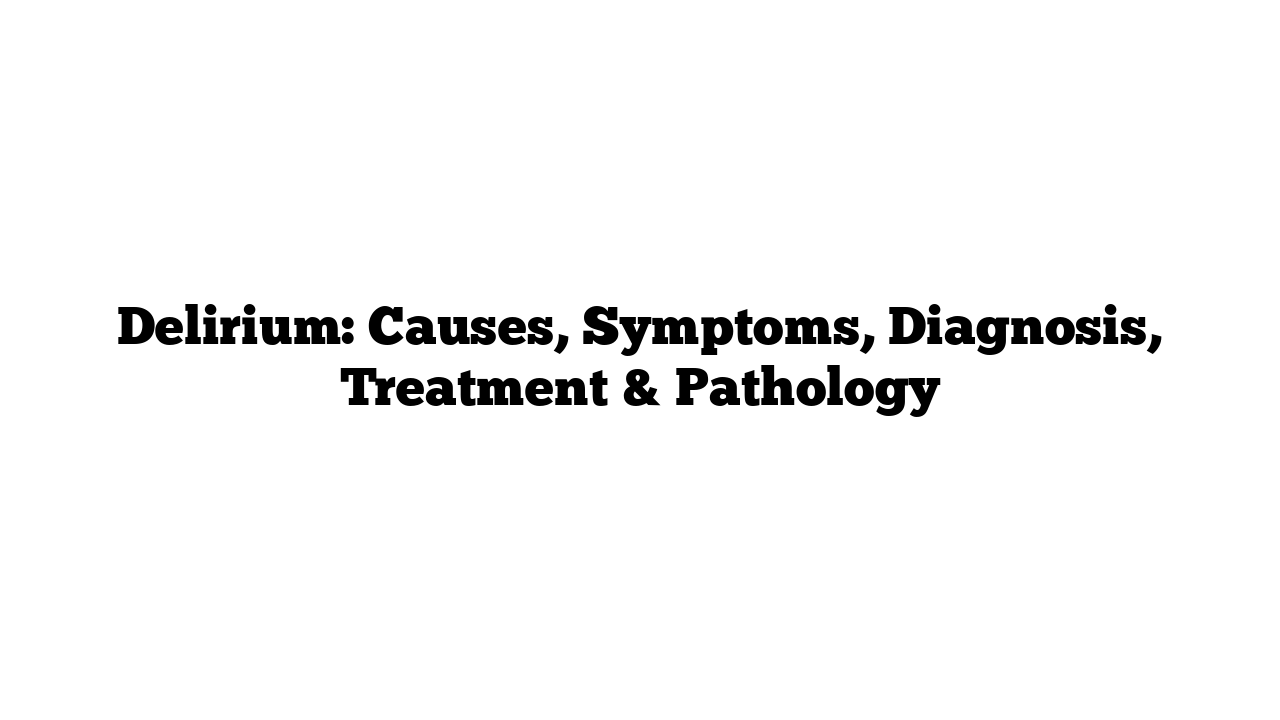What is Delirium?
Delirium is a serious and common neuropsychiatric syndrome, particularly affecting older patients with multiple medical issues. In fact, up to 50% of elderly patients in the hospital experience delirium at some point, though it can occur in people of all ages, including children (though less commonly). Delirium manifests as sudden changes in mental status, causing patients to experience confusion, agitation, hallucinations, or even delusions. It can be scary for both the individual and their caregivers, as the onset is often rapid and unpredictable.
Symptoms of Delirium
Delirium can manifest in two forms: hyperactive and hypoactive.
- Hyperactive Delirium: Involves agitation, aggression, incoherent speech, delusions, and hallucinations. Patients may also become disoriented and confused, not knowing where they are or why they are there.
- Hypoactive Delirium: Patients become drowsy, sluggish, withdrawn, and less reactive. They may also fear hallucinations and withdraw even further.
Sometimes, patients experience a mixed-state delirium, which includes both hyperactive and hypoactive symptoms at different times.
Delirium vs. Dementia
Though delirium and dementia share some similarities, they are distinct conditions. The key difference is that delirium has a sudden onset, while dementia is a gradual decline over months or years. Patients with dementia may still have normal behavior in the early stages, whereas delirium is marked by confusion and hallucinations. Unlike dementia, delirium is usually temporary and resolves once the underlying cause is addressed, often within hours to days.
Causes of Delirium
The exact cause of delirium is not fully understood, but several risk factors are identified:
- Medications: Certain drugs, like narcotic pain relievers, benzodiazepines, and anticholinergics, can contribute to delirium.
- Post-surgical recovery: Recent surgery, especially in elderly patients, can trigger delirium.
- Infections and medical conditions: Pneumonia, urinary tract infections, or other illnesses, especially in older adults, increase the risk.
- Sleep deprivation: Poor sleep in a hospital setting can exacerbate delirium symptoms.
- Other factors: Fatigue, dehydration, electrolyte imbalances, or even the presence of dementia or cognitive impairment.
Pathophysiology of Delirium
Although no single cause has been pinpointed, there are several theories:
- Neurotransmitter imbalances: Disruption of neurotransmitters like acetylcholine and dopamine may play a role.
- Membrane depolarization: A failure in neuronal membrane function could impair communication between neurons.
- Inflammatory cytokines: Infections or trauma might release inflammatory markers that disrupt normal brain function.
Diagnosis of Delirium
Diagnosing delirium involves assessing symptoms, reviewing the patient’s medical history, and conducting tests to rule out other causes. Key factors include:
- A sudden change in mental state
- Symptoms like agitation, hallucinations, or confusion
- Blood tests, CT/MRI scans to rule out other medical issues
- An EEG to assess brain activity, if needed
Treatment and Management
The primary goal of treating delirium is to address the underlying cause, whether it’s an infection, medication side effects, or another medical condition. Key aspects of treatment include:
- Medication management: Limiting medications that can trigger delirium (like narcotics or anticholinergics) and managing pain with non-opiate drugs.
- Sleep management: Ensuring the patient gets proper rest and maintaining a consistent daily routine.
- Environmental adjustments: Reducing noise, ensuring the patient has their glasses or hearing aids, and making them feel more comfortable and oriented.
- Medications for severe symptoms: In some cases, medications like Haloperidol or antipsychotics may be used to manage agitation or severe confusion.
Prevention of Delirium
Preventing delirium involves identifying high-risk patients early and taking steps to minimize triggers:
- Assessing risk: Healthcare teams should be vigilant in identifying patients at risk, such as those with multiple health conditions, recent surgeries, or medication use.
- Managing basic needs: Ensuring proper hydration, nutrition, sleep, and physical activity can help prevent delirium.
- Minimizing medications: Using non-opiate pain medications and avoiding drugs that can exacerbate delirium symptoms.
Long-Term Effects of Delirium
Delirium can have serious long-term consequences, particularly related to falls. Patients with delirium are at a much higher risk of falling, which can lead to injuries like broken bones or head trauma. This risk increases the chances of longer hospital stays, more complications, and even higher mortality rates.
Conclusion
While delirium is a temporary condition in many cases, its symptoms can be distressing and disruptive. Early identification, prompt treatment, and preventive strategies are crucial in managing this condition, especially in high-risk groups like the elderly. With proper care, delirium can be managed effectively, and its long-term impacts minimized.
